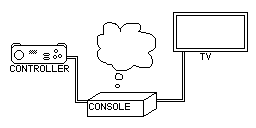Display lag: Difference between revisions
m (Text replacement - "\[\[(:)?Image:" to "[[$1File:") |
mNo edit summary |
||
| Line 3: | Line 3: | ||
{{art-wikipedia}} | {{art-wikipedia}} | ||
'''Display lag''', also known as '''input lag''', is the delay between a console producing output and a television displaying said output. In most cases, it is caused by high-resolution televisions imposing additional processing on the visual data it receives in order to make it look better. While this feature is useful for non-interactive applications, such as video playback and technical demos, it goes against the real-time nature a majority of games require, thus resulting in the illusion that there is an in-game delay between input and action. | '''Display lag''', also known as '''input lag''', is the delay between a console producing output and a television monitor displaying said output. In most cases, it is caused by high-resolution televisions imposing additional processing on the visual data it receives in order to make it look better. While this feature is useful for non-interactive applications, such as video playback and technical demos, it goes against the real-time nature a majority of games require, thus resulting in the illusion that there is an in-game delay between input and action. | ||
Display lag is difficult to quantify but easy for players to detect; [[controller]] feedbacks or inputs may be delayed, and the [[Wii U]] GamePad's screen may not be in sync with the television. It can be described as similar to [[Wi-Fi lag|playing online]], though at a more constant and predictable rate. | Display lag is difficult to quantify but easy for players to detect; [[controller]] feedbacks or inputs may be delayed, and the [[Wii U]] GamePad's screen may not be in sync with the television. It can be described as similar to [[Wi-Fi lag|playing online]], though at a more constant and predictable rate. | ||
Revision as of 22:31, July 6, 2021
Display lag, also known as input lag, is the delay between a console producing output and a television monitor displaying said output. In most cases, it is caused by high-resolution televisions imposing additional processing on the visual data it receives in order to make it look better. While this feature is useful for non-interactive applications, such as video playback and technical demos, it goes against the real-time nature a majority of games require, thus resulting in the illusion that there is an in-game delay between input and action.
Display lag is difficult to quantify but easy for players to detect; controller feedbacks or inputs may be delayed, and the Wii U GamePad's screen may not be in sync with the television. It can be described as similar to playing online, though at a more constant and predictable rate.
Even with small amounts of display lag, some games with stringent timing requirements, such as rhythm games, may become difficult or infeasible to succeed at. For the Super Smash Bros. series specifically, every frame of display lag decreases the possible reaction time of players, increasing the amount of prediction necessary to win and widening the size of a character's safe movepool.
Owing to concerns over display lag, tournaments for Smash 64, Melee, Brawl, and Project M heavily favour setups with older, cathode ray tube televisions (more commonly known simply as CRTs) that lack display lag. As Smash 4 and Ultimate do not properly support 4:3 screen ratios that CRT televisions use, modern televisions must be used for the games' tournaments. As a result, televisions used at such tournaments need to feature a "game mode" that reduces the effects of input lag, or need to be specifically marketed as a model intended for gaming.

